|
|||||||||||||||||
November 2009 Web Edition Issue #3 |
|||||||||||||||||
| Mondo Cult Forum Blog News Mondo Girl Letters Photo Galleries Archives Back Issues Books Contact Us Features Film Index Interviews Legal Links Music Staff |
 LettersMondo Cult Readers and Writers
May 24, 2016
Jessie, Since this is likely to be the only Letter to the Editor I'm sending to Mondo Cult, there is an opportunity for public praise. It has been a pleasure working with you all these years. The job you did on the magazine and the way you handle your site reflect good taste, integrity and a sense of fun. Thank you. The reason I'm writing a letter is to make the following comments more personal than a publisher's statement. I'm writing as a writer. Despite minimal impact on Mondo readers, I still believe that Kent's article, "The Lone Writer Theory," is unusually important. He puts "Profile in Silver" in historical context. Writers who succeed in being published, or produced, deserve respect from other writers. It's that simple. J. Neil Schulman is living inside a Rodney Dangerfield joke. He doesn't get any respect. After Kent's article appeared at the site, I got around to reading the March issue of Rolling Stone. Here is a portion of an article from "The Plot to Save JFK" by Andy Greene: "When Stephen King first got the idea for a story about a teacher who goes back in time to save John F. Kennedy's life, it was 1971 and he was a high school teacher unable to get published outside of softcore-porn magazines like Cavalier and Gent. "I was teaching school, and one day in the teachers room I thought, 'Jeez, wouldn't it be cool if somebody could go back and stop the assassination?'" King says. "But I decided the history research would be too much for a high school teacher, so I shelved it." It would take 40 years for King to publish the book, 11/22/63, but it was worth it." So, it was 1971 when King got the idea of traveling back in time to stop the assassination of JFK? 1971 was an interesting year. King, Neil and I were young adults. I was a college student. King was a high school teacher. Neil and I are 63 years old as I write this. King is a little over a half decade older.
Neil's King's novel, and the resulting miniseries, came out in the 21st Century. There are two dates that I would like to introduce into this discussion. They are 1/13/61 and 3/7/63. Those are the dates of classic episodes of The Twilight Zone, both written by Rod Serling. Neil grew up with the Zone. I grew up with the Zone. And Stephen King refers to The Twilight Zone as "damn near immortal" in his book, Danse Macabre. All the baby boomers watched the show on CBS, and the endless reruns in syndication, long before we could collect episodes. 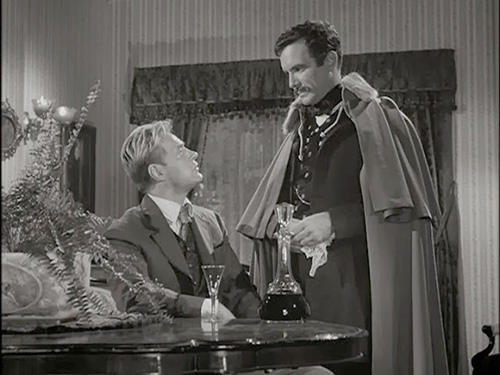 Russell Johnson as Pete Corrigan and John Lasell as John Wilkes Booth in "Back There". On January first, in the year 1961, TZ aired the episode, "Back There." The hero, Russell Johnson, travels back in time and finds himself in a position to try and stop the assassination of Abraham Lincoln. Although he fails to save the President, he inadvertently changes history in another way which sets up a surprise ending. On March seventh, in the year 1963, TZ aired the episode, "No Time Like The Past." The hero, Dana Andrews, travels back in time to various points in history and discovers he can't change a gosh darned thing. (Was this a possible inspiration for Irwin Allen's The Time Tunnel?) At one point, our hero considers trying to prevent the assassination of President Garfield, but lets the matter drop when he realizes, yet again, that the timeline can't be altered. Speaking of timelines, the two dates of these widely viewed broadcasts precede the assassination of President Kennedy. How many writers saw these episodes before Dallas? How many writers in the many decades since have seen these episodes? How high is up? At the time of Serling's stories, only One Presidential Liberal Icon had been murdered. Now the list is two: Lincoln and Kennedy. Over a long stretch of years, how many writers familiar with Serling's work might have put two and two together? Originality is a tricky thing. Every writer knows the game is to be original enough. This is not to say that true originality never happens. It does, rarely. As long as we're considering time travel, here is an example of original thinking. In the last decade of the 19th Century, H. G. Wells imagined time travel, coined a new term as the title of a novel, The Time Machine, and then sent fiction's first time traveler so far into the distant future that the evolutionary process had split the human race into two different species. That was original, back there. There's nothing remotely original about traveling back in time to save JFK, especially after Serling already did it with Lincoln. The idea is obvious enough. Personally, I would have preferred Neil writing about a time traveler going back to save Marilyn Monroe, if you get my drift. The most original thing about "Profile in Silver" is that it wasn't written by a liberal, but a libertarian! Only a science fiction writer could imagine something like that. Another thing is that Neil did a beautiful piece of writing with convincing characters and the right tone. He got there ahead of a certain monarch. Finally, details matter. Neil's tornadoes (a result of disrupting the time stream) provide an original touch in a story like this. Somehow, those tornadoes crossed a lot of time zones and ended up in King's version. Maybe he was traumatized by a cyclone back in 1971 and ended up on the road to the Emerald City. Green is the color of success. By the way, if readers want to check out a credible work on what two terms of President Kennedy would have been like, it's not to be found on television or in a doorstop volume. I refer to If Kennedy Lived, the First and Second Terms of President John F. Kennedy: An Alternate History by Jeff Greenfield. The novel clocks in at a paltry 249 pages. There's no good role for James Franco. The book's only merit is intelligence (not a reference to the CIA). Meanwhile, back in our world of unfettered imagination and wonder, it would be nice if Today's Celebrity Authors, ensconced on their Celestial Thrones, might occasionally acknowledge mere mortal writers who did certain things before they did. Just sayin' . . . . Brad Linaweaver 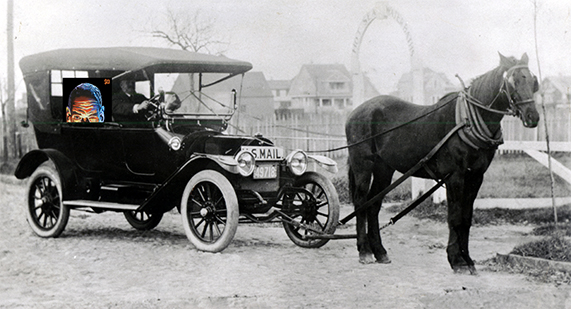 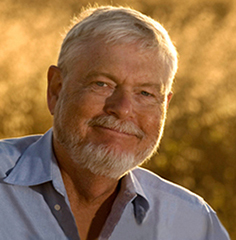 Greg Benford June 12, 2012 --for MONDO and its many delights. Liked the reviews, stills, joke shots etc. Agreed the Patterson views of van Vogt are spot on, and the review of his Vol 1 too. This took me back to my youth, when sf/horror was cheesy yet fresh somehow. Tom Reamy & I used to go to pics in Dallas and laugh at the cheap special effects--but they worked anyway. I was sorry our multiple pitches to the RAH Trust failed; they're really out of it, alas. I have little hope for RAH in visual media after this. Hope to see you soon! Greg BENFORD 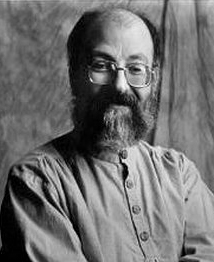 Harry Turtledove May 30, 2012 Hi, Brad. Thanks very much for sending this to me. Entertaining and interesting as always. Apologies for not getting back to you sooner--I'm just coming up for air after finishing a book. Very interesting piece on Rondo Hatton. Remember the Sturgeon story where the essentially superhuman protagonist gets acromegaly? Well, there it was for real. And the review of Bill Patterson's Heinlein bio was also quite good. I picked a few nits with Bill, but only a few, on historical details of the 1940s. Hope you're well and thriving. --Harry
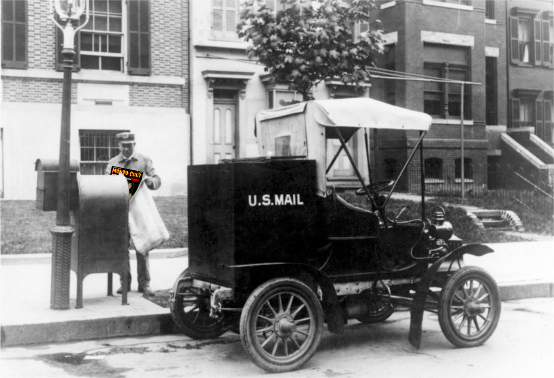 Hey Brad: Ah, yes, another too-cool-for-words issue of “Mondo Cult”, albeit a doorstop-sized one (which is, in itself, too cool for words) and even more cool for words is finding my last letter within mere millimeters of Frank Darabont’s letter there in the letters column—I’ve always been a huge fan of Frank’s (who isn’t?) and I remember finding out long after the fact that apparently I used to stroll past his office on almost a daily basis when he was typing away on some script or another at “The Lot” in Hollywood (it’s the old Warner Brothers Lot now simply called “The Lot” as Warner Brothers long ago moved its main facilities to Burbank—even so, “The Lot” continues to function as a working studio, i.e., they’re still filming the vampire series, “True Blood” there and it’s the hangout for writers and directors all over the freaking place, including Darabont). The tragedy is, I never realized that that was him—as a matter of courtesy, I don’t go out of my way to stare into people’s offices while they’re working, much less disturbing them in any way—so I never did meet him face-to-face which irks me to this day (it’s something like my almost comic near misses with Cuba Gooding, Jr.—he’ll be in the same elevator with me, or joining one of my producers at the same dinner table at a Hollywood night club, or we’ll pass each other in a production company’s hallway somewhere, yet I’ve never actually managed to say “hello” even though we’re often within two or three feet of each other—go figure). But I always admire people who work their way from the bottom to the top, and Darabont started by crewing for films and ended up an Oscar Award winning writer and director well known for his Stephen King adaptations (and justifiably so) so he’s always been kind of a personal hero for me, so you have no idea how irritating it is that I repeatedly missed an opportunity to just say, “hey, you’re cool”. Just typical of my luck (although to be fair, my time at “The Lot” did net me my sale to Playboy of the screenplay that would eventually trigger Playboy’s “Club Wildside” franchise of three films via Playboy Productions as well as the sale of a larger science fiction action feature to Millennium Productions—most recently notable for their production of Stallone’s “The Expendables” and the new “Conan” movie—although that one still has yet to get produced, although I may get around to fixing that one of these days). 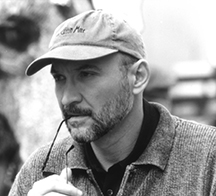 Frank Darabont But to backtrack to the cover, it’s also a cool thing to see Brinke Stevens (as she’s attacked by the Tingler) there as well (and even a better surprise to discover her update on what she’s been doing via “The Brinke Blurb” just a few pages into the issue—of course, she mentions Don Glut and Dan Golden, and we both have some stories there, some of which may not be appropriate for prime time, so I’m censoring myself here). But as you know, she was one of my inspirations for my full feature screenplay adaptation of your own short story, “A Real Babe” (just as she was your inspiration for the same story), which, of course, has since been adapted into an audio play (I’ll let you inform the readers where they can pick up a copy) and, one of these days, I truly hope we’ll have a chance to get my feature screenplay version filmed as well (I still consider it one of my best screenplays) and add it to my fairly decent-sized stack of produced feature film credits and maybe even have it serve as a critical component of your collection of collaborated stories, the Brad version of Harlan Ellison’s breathtaking can’t-be-recommended-enough “Partners in Wonder” collection. Anyway, I will get it done one of these days, but, as they say in Hollywood, “nothing ever happens as fast as you want” and ain’t it the truth? But speaking of Hollywood, Eric Caidin’s coverage of the film scene in Hollywood (and then Vegas, and then Hollywood, and then Palm Springs) was a fun read—I should probably take advantage of some of the ongoing film festivals and film fan get togethers at the Beverly Theatre one of these days (God knows I drive past it often enough during the week) but my current work schedule keeps cutting into my fun time, even interfering with my decades long residence at many a Hollywood and Beverly Hills night club, but duty calls as I shift gears from screenwriting into producing and learning that that means I have no social life, just work, work, work, seven days a week (then again, I kind of like this kind of work, so what the heck). But sorry to read of the passage of film directors Bob Clark and John Flynn in Eric’s column, yet pleasantly surprised to see that Mickey Rooney is still with us to this day—I had a chance to cast him in a small Christmas project that, unfortunately, ultimately went nowhere (typical of about half of my 40 or 50 feature screenplay sales) but maybe I’ll get to work with him yet. As for the “Publisher’s Sermon”—that covers some of what I’ve already covered in this letter, and for the rest, I’ll hit on that too momentarily, but what a cool photo of Ray Bradbury, yourself and “Crustacean” director L.J. Dopp (the title reminds me of when I got thrown out of Beverly Hills ritzy restaurant “Crustacean”, along with “Predator” Executive Producer Laurence Pereira, because I wasn’t wearing a jacket, making it the first time for both of us getting tossed out of “Crustacean”, much to his irritation. So I went back to my car and picked up a jacket, a black leather biker’s jacket, and they had to let us back in on a technicality, although my choice of jackets didn’t seem to help Laurence’s irritation much and I don’t think the management was too awfully thrilled with my choice of jackets either). Anyway, aside from that, you know, we had a great photo of yourself, myself and Ray from one of his plays that I should probably send to you to perhaps use in a future issue of “Mondo” (now if I can just figure out where I put it for safe keeping). 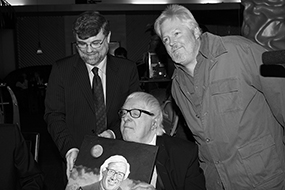 L.J. Dopp (right) presents his portrait of Ray Bradbury at Forry's 90th Birthday Party to the Martian Chronicler himself. In attendance, our publisher. But, speaking of photos, there’s certainly something to admire in Paula’s photos from “The Evening at Rocket Video” where I dropped by myself for a little bit. I remember it being a fun evening, Paula being quite the lady and Richard Hatch being quite the gentleman as usual, and the “Magellan Prologue” as the next article on the facing page is quite appropriate as a result. You and Richard have done quite an excellent job on your three “Galactica” novels so everyone can expect the same outstanding quality in “Magellan” (and maybe one of these days, we’ll see the fourth and final “Galactica” from you both as well, plus it would be kind of cool to see all four bound together in a single omnibus as the single story that they are, à la the single edition “Lord of Rings” versions that are floating around out there, published as Tolkien originally wanted). And as for “The Boneyard Collection”—always fun to see another Ed Plumb production (and always fun to go to his parties as well—you never know who you’ll meet there, recalling a pleasant and long conversation with “Twilight Zone”/”Logan’s Run” writer, George Clayton Johnson, at one of Ed’s gatherings). Of course, the long segment, “Her Morbid Desires” is kind of the other half of the already mentioned “A Real Babe”, so even more incentive to make sure I get the feature adaptation of “Babe” produced one of these days, but between “Her Morbid Desires” and L.J. Dopp’s writer/director version of the silly (deliberately so) “Cry of the Mummy”, you get a fun little “behind the scenes of horror Hollywood” film (and since the article functions as a “behind the scenes” of “The Boneyard Collection,” technically, it’s a behind the scenes article of a behind the scenes horror film, which is uniquely unique) and the following quick article on “Boneyard” alumnus Diana Catania by Ed is a nice touch too (plus a great photo of her) but the Ray Harryhausen interview is obviously a major coup (I’d expect nothing less of “Mondo Cult”) and if I can find any fault there, I would just say that it wasn’t anywhere near long enough—obviously, with Ray’s history, you could do a freaking book length interview and it still wouldn’t be long enough—but, as usual, great job, Brad . . . So, of course, you follow it with another major coup—a book length interview with Fred Olen Ray. Needless to say, this is a definitive (the definitive?) Fred interview, but, again, I’d expect nothing less in “Mondo”. Fred’s love of the old sci fi and horror classics just shines through the interview, and his extensive knowledge of all of these movies is just too scary to contemplate, but the fact that he not only preserves them and, in some cases (i.e., “The Last Woman on Earth”), actually makes them better in his re-release is cool too (plus him getting Roger Corman involved in what is technically a competing company’s project is, by itself, quite a coup too. To this day, I still can’t believe I never did break into the Corman clique, even though I was one of the few screenwriters ever to get a double thumbs up through his gauntlet of two readers for every script and the fact that I literally lived just across the alleyway from his office at one point, literally within 100 feet, making me the absolute closest screenwriter living next to Concorde New Horizons and yet nada, I never did a Corman film—just typical). But it’s always amusing to see which of Fred’s actresses I know and/or who have been in some of my films (hi, Julie!) but as for the effect of one of Fred’s “Bikini” movies (“Bikini Airways” to be specific) on my NASA rocket scientist/model/pilot lady friend at the time, I’ll refer the readers to my previous letter in the previous issue of “Mondo”—it seems everyone’s a critic. Ah well, it probably wasn’t meant to be anyway. And the Arthur Pierson article was informative—at the risk of sounding ignorant, I actually had never heard of him before, but as a fan of every kind of Hollywood history, I’m automatically a fan of this kind of article (for that matter, I guess that automatically makes me a fan of “Mondo Cult” in general for the same reason). Plus as someone who knows Mike (the author) personally, quite an impressive job there (good one, Mike!) so very nice, very well done, and a pleasure to read and to find out about another piece of Hollywood history (and about Arthur) that I had somehow missed. Way cool. As for William Alan Ritch’s excellent “B for Betrayal”, we had talked about this article separate from the magazine publication and prior to the magazine publication, so, in a way, I already knew what I would be reading, but Bill did an excellent job as usual and as someone working in the trenches of Hollywood, I can certainly appreciate the focus on artistic integrity—I can’t even count how many times I have stood on a set and watched them film a scene from one of my scripts and not recognized anything that I was watching—so his point that the primary points of the original work have been totally twisted around is a point that hits home with me personally, and Bill clearly makes that point, starting right up front, in the first few seconds of the film, that this is a total and unnecessary reworking of the Alan Moore’s masterpiece by the directors (the Wachowski Brothers, now effectively persona non grata in Hollywood due to their subsequent feature misfires) who feared, or even totally opposed, the political message of the original (this, of course, begs the question of why did they bother in the first place in that case?). Anyway, a very perceptive and telling analysis of the deliberate running-away-from-political-controversy of the film adaptation of “V for Vendetta”—but immediately afterward (next page), I was surprised to find up front a review of the old “Crucible of Terror” which I saw waaaaay back when, but this comprehensive article makes me want to go out, find it and see it again, which I think I’ll do in the not too distant future. ...speaks for itself... “The Tingler”, however (like the aforementioned “Crucible of Terror “), was one I caught a gazillion years ago, and it pleases me no end to find Chris Schaefer’s well-written history of “The Tingler” in “Mondo”. I’m guessing we’re all looking at an excerpt from his master work, his huge biography of William Castle which will (I hope!) see publication in the not too distant future, and if this article is any indication of the quality of the rest of the book, we’re in for a real treat when it finally hits print. But in the meantime, it’s great that we’ve got a magazine like “Mondo” to give us glimpses of master works like this in progress (now if we can just get Brooke to pose for the cover of the book . . .). And, of course, Jessie’s interview with horror host, Dr. Gangrene, was entertaining—perhaps he might be the right choice to host a screening of the underground classic, “Midnight Madness” (see the P.S. Section from my previous “Mondo Cult” letter) assuming of course, that we can ever find a way to trick Joe Dante and/or Alan Arkush to do another screening of the full (7 hour) cut (I’d actually prefer to see the 7 hour cut over the 4 hour cut—also, I realized I forgot to explain in my previous letter where I kept referencing “Midnight Madness”, for those unaware of what exactly it is, it’s Joe Dante’s and Alan Arkush’s huge film that they edited together from a stack of 50’s sci fi/horror films as a result of them noticing that the same actors always played the heroes and villains and damsels in distress, and so they decided to create a super 50’s sci fi/horror film starring all of them playing their traditional roles as they faced off against a somewhat non-specific alien threat. The resulting monster-sized film briefly hit the college late night film circuit at one point, but since then, it’s vanished, never to be seen again, a condition I’d really like to correct one of these days—and, by the way, surely a “Midnight Madness” article would be appropriate for a future issue of “Mondo”, no?).
But to find a review of “1776” back-to-back with a review of “Letters from Iwo Jima” in the same magazine? Now that is esoteric. And while musicals are not necessarily at the top of my preferred films to see, I’ve occasionally caught a few in the past, and since the review points out that the DVD cut does restore a significant portion of the film, it might be worth another look (my last look having been a few decades back)—I’m one of those who almost always prefers the director’s intended cut, even if it’s a bit too long to be “commercial” as they say in the biz (just as an aside, this “commercial” screening time problem appears to be why the original “Dune” by David Lynch got cut to ribbons—a distributor stood up during a screening of the then-still-being-edited 4 hour version and shouted, “This is going to kill us!” referring to the fact that the distributors needed to run a certain number of screenings of a film per night to make a profit, and the 4 hour cut of “Dune” was going to knock those profits down by 50%, hence the abortion that you eventually saw in the theaters and David Lynch furiously walking away from his 4 hour version, leaving it incomplete to this day—when you see “his” 4 hour cut out there on DVD, you might want to notice the Director’s credit is “Alan Smithee”, the official Director’s Guild pseudonym to be used when a Director feels his work has been destroyed to the point where he wants his name off of it—so, actually, no one really knows what his actual version might have been—ditto for the three and a half hour cut of the second “Crow” movie, which was released as a two hour or shorter cut, or the six and seven hour cuts of the war movies, “The Big Red One” and “The Thin Red Line”).
But long aside, like I said, it was certainly unique to see “1776” and “Letters from Iwo Jima” back-to-back in a magazine—needless to say, even with some of the flaws pointed out by Daffyd and Sachi, “Letters” was still a pretty impressive film, but then, whenever you’ve got Clint behind the camera, you’d expect no less. I do remember a lot of the action producers being intrigued by the fact that it was a war action film written by a woman which, sexist or not, is indeed a rarity in Hollywood, but the director wanted to have that different approach to the film and I’d say it was clearly the right choice. But speaking of choices, the fact that the James Mason version of “Journey to the Center of the Earth” had to be restored is sad news indeed. John DeChancie’s review of “Journey” reminds me of when I saw it (and saw it, and saw it again and again) a couple of centuries ago, but, you know, while it may not work well with modern audiences, like John, I also still have some fond memories of the film, the somewhat silly effects and the humongo fake-o lizards notwithstanding, and it’s clear John does too (and having stumbled across a radio interview with Pat Boone a few years back, apparently he still has pretty good memories of the film as well). That said, did anyone actually see the 2008 remake with Brendan Fraser? I admit to being kind of a Brendan Fraser fan—even when he totally misses, i.e., “Dudley Do Right” or that Tim Burton thing that didn’t quite work—you can see he’s trying, and this might have been worth catching, but it was gone from the theaters so fast that there was almost a sonic boom (something like his third excursion with “The Mummy”). I have a funny feeling though, it probably isn’t quite as memorable as the 1959 version. But as for films that definitely work, Jerry’s review of “The Chronicles of Narnia: The Lion, The Witch and the Wardrobe” makes the point that the CGI-intensive adaptation of fellow “Inkling” writer, J.R.R. Tolkien’s “Lord of the Rings” kind of paved the way for this latest version of “Chronicles” and, consequently, that this was indeed the right time for this adaptation. Jerry makes a good point—I thought it definitely worked, and C.S. Lewis’s seven volume series is clearly on its way to becoming a huge franchise à la “Rings” in its own right, massively helped along by the power of contemporary computer-generated special effects.  As for Neil’s “Lady Magdalene’s”, while the “Narnia” films have clearly found their audience, “Magdalene’s” clearly still has not even though it’s obvious by its content and by the fact that it’s won multiple awards that there’s very clearly an audience for it, a fact that seems to have sailed over the heads of most Hollywood distribution companies in spite of said multiple awards, so I remain a little puzzled by this one and I keep hoping that Neil finds a home for his film soon. Plus when you look at some of review of the “B” films that follow in the magazine (starting with Buddy’s review of “Scared to Death” and up to Jessie’s “Godzilla” article), you have to wonder about what Hollywood chooses to distribute at times. But I’m still rooting for Neil finding that distributor real soon now. And backtracking half a sentence to Jessie’s fond remembrance of getting a phone call from you, Brad, offering her the chance to catch a “Godzilla” screening with none other than Forry Ackermann, that’s truly a cool remembrance (plus I note her mention of the possible free copy of “Bubba Ho-tep” which, conceptually, I still think is one of the funniest concepts for a silly horror film ever—if you haven’t see it, go see it and you’ll see what I’m talking about). Anyway, I think all of us who had a chance to know Forry all have many fond memories of him—my own include dragging along Penthouse Pet of the Year Cheryl Rixon to several Forry gatherings which I think may have made his decade at the time—and, of course, there’s the sadness of attending his funeral where even then I learned some amazing things, i.e., that Director Guillermo Del Toro had been massively influenced by Forry, which I never knew and which is just too cool for words on so many levels I can’t even begin. But, like Jessie, like us all, I miss him too and the world of science fiction and horror remains forever lessened by his loss.  Original drawing by Martina Pilcerova But on a happier note, Bill Ritch’s overview of the entire never ending “Dr. Who” series was a lot of fun. While I’d be the first to admit that I’m not a huge “Dr. Who” fan, I’m also the first to admit that maybe I should have been, but, at this point, just the thought of trying to catch up on decades of back episodes is just terrifying when I can’t even make enough time to watch the films I want to see, so it makes the whole thing problematic, but Bill’s overview definitely fills in a lot of gaps for me (and those of us who have managed to miss bits and pieces over the years) and from what I’ve seen of the most recent versions/incarnations of the Doctor (Eccleston and Tennant, courtesy of late nights with the SyFy Channel, BBC America and PBS), maybe I should at least try to make a little more time to get caught up on the series. Fingers crossed. But speaking of stuff I’ve missed, like the person asking questions in the first paragraph of Jessie’s review of 1958 “Steve Canyon” series, I also have to admit to ignorance as well—there was such a series? Sheesh. The things you miss (but waaaaay cool that Charles Beaumont from the “Twilight Zone” series contributed a script—I was going to go off on a tangent about “Twilight Zone” writers and the impact they’ve had on all of us other writers, but that would add another 20 pages here, which is probably not a good idea). But thanks to DVD releases of complete series (like “Steve Canyon”) and the miracle of DVD stores like Amoeba in Hollywood, there is a way to get caught up if you’ve got the time . . . and speaking of Amoeba, that’s where I also first found out about the science fiction series, “Odyssey 5” (the next review by Neil—and, actually, Amoeba is how I found out about a lot of series I never heard about). How I managed to miss this Showtime series, I don’t know (then again, looking back at the rest of this letter and my impressive track record of missing major films, maybe this makes sense) but I’ve been impressed with producer Manny Coto’s other series (“24” of course, and yes, “Star Trek Enterprise” too, which I think was unfairly kicked about by a public that might have become a bit tired of the franchise, which was not the fault of “Enterprise”—then again, J.J. Abrams’s 2009 “re-imagining” of “Star Trek”, was undeniably impressive—let’s just hope he does as well on the sequels). Anyway, “Odyssey 5” is a series that I truly regret completely missing—unlike “Dr. Who”, I never even heard of “Odyssey 5” nor did I ever even see a single episode, until I stumbled across it at Amoeba, and now that I’ve read Neil’s excellent review, maybe I should actually try to make time to look at a few episodes at least at some point). And skipping ahead (saving the best for last), Jerry’s interview with stunt woman Kim Stys reminds me of my time spent on a stunt team with actress Dana Fredsti (who had worked with another lady friend, Heather, on Raimi’s “Evil Dead 3—both were among the undead)—I recall at some point in the film, when I wasn’t getting killed or machine gunning innocent civilians, that the stunt coordinator literally ran up my back and leaped onto a biker who I was battling at the time, but I was so tired that I never even noticed, and then after the film wrapped I remember coming home and calling Dana and both of us realizing that we couldn’t move. So, yes, I’m much impressed with any stunt people who can handle that on a regular basis, so hats off to stunt woman Kim Stys. After my own stint in the stunt person trenches, I went back to screenwriting and never looked back, but it was definitely an interesting experience that I hope I will never ever repeat. And as for screenwriting, I do remember running into Playboy’s Miss November 2002, Serria Tawan, sometime not too long after she came off of the “Low Budget Time Machine” shoot—she was dropped by the offices of agent/producer Alex Ross several times while I was just hanging around and goofing off and discussing various scripts I was working on, so Kathe’s reminiscence of her work producing “The Low Budget Time Machine” and “The Vampire Hunters Club” just reminded me of running into Serria (and I wonder what Serria is doing these days?) and reminds me of just how small this business is—no matter where you’re at in the entire world, if you’re part of the film business, you always run into someone who knows you or someone you know. One of the things I like about the biz.
Of course, for the music reviews, where the lead review is for Ennio Morricone’s “Senza Sapere Niente di Lei”, you realize that it’s not possible for Morricone to do any wrong on any soundtrack. He had me hooked from his spaghetti western days (will anyone ever forget the theme for “The Good, The Bad and The Ugly”?) and I probably should have joined his record club (now a CD club) back in the day. Metallica now opens all of their concert tours with one of Morricone’s tracks (and plays their heavy metal version of some of his work in their concerts) and even writers like Harlan Ellison wax eloquent over his work so there’s nothing I can add except to say that it’s yet another positive nuance to this issue to find his Morricone’s work reviewed here. And then also subsequently noticing (on the opposite page) that David Paul Campbell is the exact double for William Castle biographer Chris Schaeffer is an amusing discovery (he’s Chris’s twin!) as is finding out that Johnny Winter cut an album with Muddy Waters (he did?)
But, being the heterosexual male that I am, your Traci Lords material (interviews, and more interviews, followed shortly thereafter by even more interviews which are then followed by other interviews) is a major coup for the issue and quite possibly the best Traci Lords interviews (or excerpts from a really big interview) ever done, so super congratulations on that, Brad. This truly takes this issue of “Mondo” into the spectacular category, and ping ponging around the different interview pieces, I see that you managed to cover her writing, her music and, of course, her acting in all sorts of projects, so what an absolutely incredible job you’ve done. This makes me truly miss not being there at Dragoncon for this legendary interview. Let’s just hope you get a chance to do an even more expansive and comprehensive follow up interview for another issue of “Mondo” in the future. You know I’ll be watching for it, but even without Traci, I look forward to the next issue of “Mondo”. But this one made my year. Great job (as usual) to you and Jessie, and with that, exit, stage right . . .
Steve Tymon
 Dear Jessie, Thank you for this copy of Mondo Cult. Good luck with your enterprise. Hugh Hefner  William F. Buckley, Jr. Dear Brad: I’m so pleased that you finally have your own journal. Nothing less than that was ever satisfactory, given how prolific and talented you are. With warm regards, William F. Buckley Jr. Dear Mondo Cult people, I really liked Jerry Jewett's review of Anarquía by Linaweaver and Hastings. By the way, 1 reviewed Anarquía in the December 2005 issue of Fosfax, alongside editor Timothy Lane's review/analysis. I believe Mr. Jewett did a fine job of reviewing the book, and I'd like to see him review other new alternate history novels. Mr. Jewett's article on Whale Rider was thought-provoking and very well written. The articles on Fay Wray and the two King Kongs contained gems of knowledge I might never have learned otherwise: e.g., Jean Harlow as Ann Darrow? The mind boggles. Jessie Lilley's article on Rod Stewart was funny and fun to read. The photo of the young Les Tremayne in Mr. Linaweaver's article on The Slime People was interesting to see; I remember Tremayne as the elderly Mr. Mentor on the 1970s Shazam! TV show. I hope that every issue of Mondo Cult is as good as this one. Well done, everybody! Yours truly,
Thomas Cron 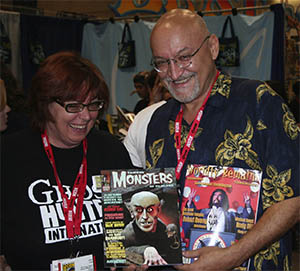 Frank Darabont and Jessie Lilley display Worldly Remains and some other mag Jessie used to edit. At the 2010 Comic Con in San Diego, CA. Dear Jessie, Late Friday, I left my editing room to spend the weekend doing a lot of napping in a friend's empty beach house. (I'm cutting The Mist and am freakin' exhausted these days.) I stopped by that newsstand on Fairfax just north of Melrose to grab some magazines for the weekend—mostly car mags and Popular Science, that's my usual. But by chance I spotted issue #1 of Mondo Cult and was really intrigued, so I had to grab it. Boy, did I love it! What a terrific publication! I spent most of the weekend (the part when I wasn't unconscious) totally absorbed in it. Love it, love it, love it! Gosh, fantastic work on the magazine. Can't wait for the next one. You're working on the second issue?
Frank Darabont Hey there, Brad: Well, as your cover page clearly recognizes, Mondo Cult has staged a major Hollywood coup by having the final interview with Fay Wray in its pages, and with that, Mondo Cult becomes a permanent part of Hollywood history (or, at the very least, it becomes a permanent footnote in every serious book on King Kong for the rest of eternity). And as interviews go, geez, talk about comprehensive - until I read it, I never knew that Fay was a writer herself (for some reason, I’m slightly biased toward writers) and I never knew that she had turned down Gloria Stuart’s role in Cameron’s “Titanic” or that Peter Jackson intended for her to do a cameo in his “Kong” remake (or that, sadly, she missed it by just one month). And while the Kevin McCarthy interview is certainly another major coup in its own right (hey, by the way, does he appear in Joe Dante’s/Alan Arkush’s gigantic and little seen seven hour 50’s movie pastiche, Movie Midnight Madness?), let’s face it, the Fay Wray interview alone made the issue. Good work, guys! 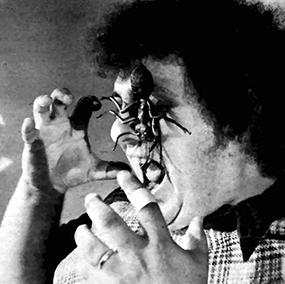 Dear Fred and Brad, lest we forget. But flipping through the pages, I couldn’t help but notice the review of Fred Olen Ray’s The Brain Leeches and remembering the first time a certain magazine editor forced me and my female NASA engineer/model/romantic involvement of the time to sit through a double viewing of Leeches and Bikini Airways. Shortly after, that relationship went down in flames. Cause and effect? I have to wonder. But I was pleasantly surprised to see Chris Schaefer’s article on Castle’s House on Haunted Hill—it’s clearly an excerpt from his massive and as yet unpublished biography of the director, and if the quality of the rest of the book is as good as his well-researched article, sign me up for an advance copy (hey, Chris, get it published one of these days, okay?). Plus, being somewhat of a Frank Lloyd Wright fan, I consider it a bonus that you included John DeChancie’s and Chris’s separate histories of Wright’s famous Ennis House - as one of the producer-writers who has filmed at another well known Hollywood house location (the three Harvard houses just off Western and the 10 Freeway), I’m always intrigued by the history of Los Angeles houses used extensively as film locations, so these supplementary articles on Ennis were muchly appreciated. As for the review of Tom Cruise’s/Steven Spielberg’s War of the Worlds, I too enjoyed the film (although I admit to having a certain fondness for the original George Pal version, outdated special effects and all) and, although I also agree it’s got some flaws, you still have to admit that whenever Spielberg and Cruise team up on any science fiction project (i.e., The Minority Report), you know it’s going to be some kind of masterpiece, and their take on War of the Worlds would certainly fall into that category. And skimming some of the other reviews, I note that while Jerry Jewett’s coverage of Whale Rider actually gets me interested in finally picking up a DVD of the film, your take on The Slime People! seems to have had the opposite reaction for some reason. Go figure. 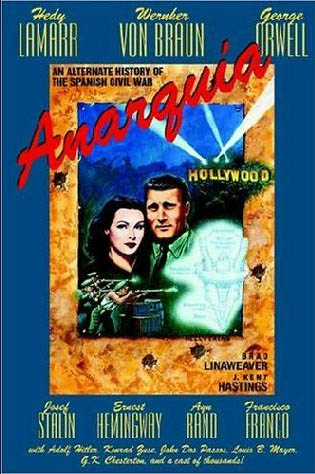 ...this oughta make Tymon happy... But, honestly, any magazine that can fit in Fay Wray’s last interview, Kevin McCarthy, Sharon Osbourne, a couple of Bradbury poems and Aerosmith all in one issue, now that’s an achievement. Like I said, great work, guys. The only question is, how the heck are you going to top this for the next issue? I’m looking forward to finding out. Sincerely,
Steve Tymon P.S. Hey, speaking of article ideas, how about an article on the earlier-mentioned seven hour masterpiece—Joe Dante’s/Alan Arkush’s Midnight Movie Madness—accompanied by an actual screening somewhere in L.A. (introduced by the directors, of course) and then a separate article covering the screening? The Egyptian theater or the Hollywood movie nightclub Cinespace, come to mind as possible locations, and if any film qualifies as the ultimate “cult film”, Midnight Movie Madness just has to be it. What do you think?  Jessie! I read the first several pages of Mondo Cult as I gorged on chicken teriyaki during my lunch break today. Here are a few of your writing segments that make Jessie so … well … Jessie! “I truly love watching the early TV series and when I stumble across them on TV Land of the SciFi Channel there is nothing that stops me from settling back on the couch (with the—this I especially love—“feline potatoes”) and wasting an entire afternoon on some marathon or another.” Then from your “One Step Beyond” review … “And if you’re as crazed as I am, you’ll go digging ‘round the ‘net, trying to find proof of the events.” And my personal favorite, from your “Outer Limits” review … “My eyes glazed over and I only left the couch to insert the next disc, get another beer or bag o’ munchies—or hit the head.” You are truly a special brand of nut!
Randy Haecker Dear Editor, The first issue of Mondo Cult brought back some terrific memories and augmented them with fascinating tidbits and a renewed appreciation for those who work in film, in all its aspects. House on Haunted Hill was one of my favorite TV horror movies when I was a kid in L.A.; I spent more time watching Elvira and Seymour than Mister Rogers (although I really loved that trolley). I wish I'd been born in time to see House during its initial release. But I was especially delighted to see Christopher Schaefer's article complemented by the sidebars about the Ennis-Brown house. There's something so intriguing about locations, and they seldom get the appreciation they deserve. I also couldn't help but snicker at the terse, get-it-over-with tone of Kevin McCarthy in Steve Bingen's interview with him. McCarthy's face and voice are iconic; his longevity in the film business, astonishing. Bingen's uphill labor to get him to engage in the interview inspires both amusement and respect. "It's all about the work," indeed.
Michelle De Lude We were delighted to have our album "Keeping On..." featured in MC #1. A mutual friend, actress Ingrid Pitt, was so excited, she announced to a gathering at her annual fan club party that we had "made it" in America. Anyway, thought you might like the enclosed photo of our cat, Tigger, who decided during recording of our follow-up album "Kites" that Bob's mandolin case fit her perfectly! We took notice of your comments about bass and drums needing to be more to the foreground and made Bob stand at the front. We felt the album much better. Indeed had it been a film sequel it would have been much "darker"! The third album (working title "Already Plastered") is almost ready. Tigger has now grown a bit and we've had to buy Bob a bigger mandolin... Congratulations on the success of issue one - wow it went on forever!!! (Brit humour, sorry!)
John Burke I was surprised and so pleased to learn that my son Christopher had written not one, but two articles on the movie director William Castle. It brought back very old memories. I remember seeing one of Castle’s movies, The Tingler, with Christopher on Halloween in 1959. It was playing in a packed theatre in Berkeley, where we lived at the time. In a brief prologue Castle urged everyone to scream if they felt afraid (a scream at the right time might just save your life!). That night it seemed most of the audience was screaming the entire time to stop the Tingler. And here we are more than 45 years later and there is still interest in The Tingler.
Herwin Schaefer About The ImagesThe icon used to separate the letters is a mail crane bag. You can read all about this and many more US Mail Worldly Remains at the Smithsonian National Postal Museum website. Stop by! 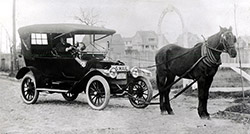
This photo, used for the letters section on Mondo Cult Issue No. 3, is from the Flickr section on the Nantucket Historical Association Library and depicts Clinton Folger and his Horsemobile. The story is charming and worth a visit. Letters for Mondo Cult Issue No. 2 sports a 1905 mail truck by parked by the rapidly disappearing local mail box, being emptied by your intrepid letter carrier. This photo was located at Wikimedia Commons. Letters for Mondo Cult Issue No. 1 shows an antique pic that can be found on Pinterest, along with a host of others. This one is from 1908.
|
||||||||||||||||





 Anyway, you might guess I’m a fan of the extended versions of the three “Lord of the Rings” films, and you’d be right. (I’m part of the crowd wondering in the initial released version of “Return of the King”, “Hey, where’d Christopher Lee go?” and, naturally, that’s what got the Oscar, much to Christopher Lee’s irritation from what I hear.) I’d also like to see the six hour cut of Tarantino’s “Kill Bill” (both parts as a single film) which did apparently exist at one point (and if you’re reading this, Quentin, I hope it exists again just before you put out “Kill Bill 3”).
Anyway, you might guess I’m a fan of the extended versions of the three “Lord of the Rings” films, and you’d be right. (I’m part of the crowd wondering in the initial released version of “Return of the King”, “Hey, where’d Christopher Lee go?” and, naturally, that’s what got the Oscar, much to Christopher Lee’s irritation from what I hear.) I’d also like to see the six hour cut of Tarantino’s “Kill Bill” (both parts as a single film) which did apparently exist at one point (and if you’re reading this, Quentin, I hope it exists again just before you put out “Kill Bill 3”).
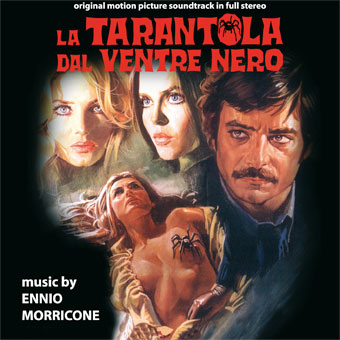 but the obituaries section was understandably a bit depressing—while I never knew Jack Williamson, I had certainly liked his work and I read a stack of his work growing up (being the science fiction fan that I was at the time and still am to this day) but with Robert Anton Wilson, I had the pleasure of being there at his place when award-winning Heinlein biographer Bill Patterson interviewed him back at his Oakland, California home a very long time ago (Bill also interviewed Robert Silverberg on the same day, there up in the hills of Oakland) and I even recall a truly surreal hitchhiking experience on the freeway in Dayton, Ohio even further back in time when Robert Anton may have been living in the area (Antioch College over in Yellow Springs, which is not far outside of Dayton, and which may be one of the most incredible small towns in America as well as being the former hang out for Rod Serling and John Lithgow) where someone who really looked like Robert Anton Wilson was driving a Cadillac convertible and accompanied by a Playboy-like lady friend and that’s who gave me a lift into town (and there’s more to this story, but I’m not putting it into print) so his loss was particularly felt (and I remain a fan of “The Illuminatus Trilogy” to this day, as does anyone who has ever read it, I’m sure). Your reviews of a couple of his books after the obit was a nice touch too. Ditto for the review of your own “Post-Nationalism” book which, as you already know, I regard as one of your most important works (and we just recently discussed a dangerous possible follow up at dinner—it will be interesting to see if you do it, now that I pointed out how your ideas explain certain current Middle Eastern strategies). And I didn’t even know that “Babylon 5” alumnus Claudia Christian had even done a memoir, so I’ll have to look that up too (of course, I’m not just backlogged on films, but you should see the stack of “I’ve got to read these” books next to my bed—there’s never enough time!). And your review of Ray Bradbury’s “A Soul for all Seasons” (what a cool title!) is a very nice touch for the ending of the magazine (his painting too), especially being the fan of Ray’s that you know I am (and, Ray, if you’re reading this, thank you for all the times that I’ve had the opportunity to attend your plays and your readings—these I regard as some of the greatest moments of my life). He is indeed the true master of fantasy writing who influences all writers of the fantastic to some degree, and how many writers can say that? Great review, Brad, and a great ending to the magazine.
but the obituaries section was understandably a bit depressing—while I never knew Jack Williamson, I had certainly liked his work and I read a stack of his work growing up (being the science fiction fan that I was at the time and still am to this day) but with Robert Anton Wilson, I had the pleasure of being there at his place when award-winning Heinlein biographer Bill Patterson interviewed him back at his Oakland, California home a very long time ago (Bill also interviewed Robert Silverberg on the same day, there up in the hills of Oakland) and I even recall a truly surreal hitchhiking experience on the freeway in Dayton, Ohio even further back in time when Robert Anton may have been living in the area (Antioch College over in Yellow Springs, which is not far outside of Dayton, and which may be one of the most incredible small towns in America as well as being the former hang out for Rod Serling and John Lithgow) where someone who really looked like Robert Anton Wilson was driving a Cadillac convertible and accompanied by a Playboy-like lady friend and that’s who gave me a lift into town (and there’s more to this story, but I’m not putting it into print) so his loss was particularly felt (and I remain a fan of “The Illuminatus Trilogy” to this day, as does anyone who has ever read it, I’m sure). Your reviews of a couple of his books after the obit was a nice touch too. Ditto for the review of your own “Post-Nationalism” book which, as you already know, I regard as one of your most important works (and we just recently discussed a dangerous possible follow up at dinner—it will be interesting to see if you do it, now that I pointed out how your ideas explain certain current Middle Eastern strategies). And I didn’t even know that “Babylon 5” alumnus Claudia Christian had even done a memoir, so I’ll have to look that up too (of course, I’m not just backlogged on films, but you should see the stack of “I’ve got to read these” books next to my bed—there’s never enough time!). And your review of Ray Bradbury’s “A Soul for all Seasons” (what a cool title!) is a very nice touch for the ending of the magazine (his painting too), especially being the fan of Ray’s that you know I am (and, Ray, if you’re reading this, thank you for all the times that I’ve had the opportunity to attend your plays and your readings—these I regard as some of the greatest moments of my life). He is indeed the true master of fantasy writing who influences all writers of the fantastic to some degree, and how many writers can say that? Great review, Brad, and a great ending to the magazine.
 People looked suitably impressed but we took a slightly more modest view...! Either that or "making it" is a much quieter affair than I imagined...
People looked suitably impressed but we took a slightly more modest view...! Either that or "making it" is a much quieter affair than I imagined...